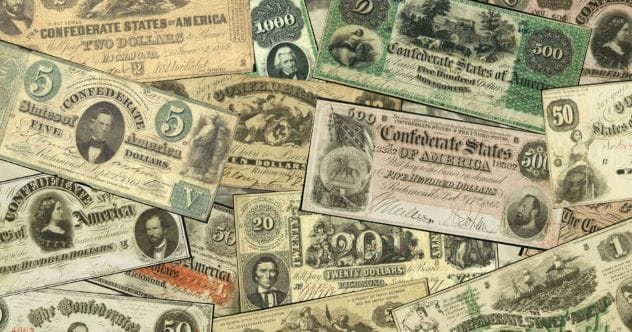Ever clutched a ten-dollar bill and wondered about its real power? We often take money for granted, trusting it’ll always hold value. But what if it didn’t? History is a fascinating teacher, showing us times when entire currencies crumbled, leaving people with stacks of worthless paper. It’s a stark reminder that even mighty money can fall.
Governments sometimes treat their currency like an endless coffee pot – just brew more when you’re running low! But this strategy, as we’ll see, can lead to a bitter end. Join us as we explore ten cautionary tales of legal tender that became legally dead, often taking entire economies down with them.
10 The Roman Denarius
Born from defiance during Rome’s intense struggle against Hannibal, the denarius emerged in the late third century BC. This coin wasn’t just symbolic; it was crafted from nearly pure silver, weighing a solid 4.2 grams. For a while, it was the king of coins, especially after Rome conquered Macedonia and its rich silver mines. The money supply boomed, and the denarius became so common that the “Roma” inscription was eventually dropped – everyone knew where it came from.
Unlike modern money, which is often backed by promises or precious metals stored elsewhere, the denarius was the precious metal. You could feel its worth in your hand. However, as Rome’s ambitions grew, so did its expenses, particularly military costs. Emperor after emperor started reducing the silver content in the denarius to stretch the budget. By the third century AD, as the empire lost territories and tax income, the denarius contained a mere 5% silver. People began hoarding older, purer coins, a clear sign of lost faith. Soon, even the government demanded taxes in gold or goods, not its own debased denarius, sealing its fate.
9 The Chilean Escudo
The Chilean escudo had a brief life, existing from 1960 to 1975, nestled between two versions of the peso. Its introduction, where one escudo equaled 1,000 old pesos, was an attempt to restore currency credibility. Things were relatively stable until 1970 when Salvador Allende, an avowed Marxist, became president. His government swiftly nationalized industries and massively increased social spending to help the poor.
Initially, Allende’s expansive money policies sparked some economic growth. But as often happens, it also ignited runaway inflation. Price hikes were worsened by widespread labor strikes that crippled production and exports. Price controls, meant to curb inflation, paradoxically fueled a booming black market, slashing tax revenues. By late 1972, inflation hit 600%, and a year later, it soared to 1200%. Chile defaulted on its international debts. After Allende’s government was overthrown, the escudo met its end. In 1975, it was replaced by the New Peso, again at a rate of 1,000 to 1. Chile then embraced market-friendly policies, leading to an economic recovery so dramatic it was dubbed the “Miracle of Chile.”
8 The Peruvian Inti
Just as Chile was introducing its New Peso and starting its economic comeback, its northern neighbor, Peru, was in a financial nosedive. Peru launched the inti in 1985, but it only lasted six short years. Once a magnet for foreign investment, Peru in the 1980s embarked on a path of increased public spending without a solid plan to manage the resulting debt—a familiar story for many nations.
Ironically, it was Peru’s move towards societal and economic liberalization that contributed to the inti’s downfall. In 1980, after 12 years, Peru welcomed its first democratically elected government. President Fernando Belaúnde’s administration significantly liberalized trade policies. While such policies can boost competition and innovation, they can also unsettle foreign investors who prefer stability. Investment dried up, inflation skyrocketed, and Peru’s existing currency, the sol, was rebranded as the inti at an exchange rate of 1,000 to 1. But the problems persisted. By late 1990, inflation was a staggering 400% per month, leading to the creation of a 10,000,000 inti banknote. It wasn’t enough. In 1991, the inti was replaced by the nuevo sol at an astonishing conversion rate of one million to one.
7 The U.S. Greenback
Wars are incredibly expensive. To fund the escalating Civil War, the U.S. government issued a special emergency currency known as greenbacks, named for their distinctive green ink. These notes were a departure from tradition because they weren’t backed by gold or silver reserves. The stage for greenbacks was partly set by the Panic of 1857, America’s first nationwide financial crisis, which left President James Buchanan’s administration in significant debt. The secession of Southern states four years later worsened the financial strain by reducing federal tax revenue.
Initially, some greenbacks, called Demand Notes, were backed by gold. However, as the war dragged on, the U.S. issued $450 million in unbacked U.S. Bank Notes. This flood of new money caused the greenback’s value to decline against gold. They were a double-edged sword: they funded about 15% of the war’s costs but also drove up the price of everyday goods, with inflation hitting 14% in 1862 and 25% in both 1863 and 1864. Despite this, the greenback recovered after the war. Ironically, its eventual discontinuation is linked to its founding principle: that money doesn’t strictly need precious metal backing. When America fully abandoned the gold standard in the early 1970s, Federal Reserve notes became the sole currency.
6 The Confederate Dollar
The Union greenback had a Southern counterpart: the greyback, the colloquial name for the Confederate States of America’s dollar. These notes featured Confederate President Jefferson Davis on the $50 bill and Vice President Alexander Stephens on the $20. The $100 bill even depicted enslaved Black people, a grim reminder of the Confederacy’s foundations. Like the greenback, the Confederate dollar was speculative currency, but its odds were much longer.
A Confederate note was essentially an IOU, a promise to pay the bearer after the war—if the South won. This made its value incredibly volatile, swinging with every piece of war news. For example, when news of the Confederate defeat at Gettysburg spread in July 1863, the greyback’s value plummeted by 20%. By October 1863, a soldier’s monthly pay of $11 reportedly had the same purchasing power as one Confederate dollar at the war’s start. Eventually, many merchants refused to accept it. As the Confederacy’s hopes faded, so did its currency. By late 1864, prices were astronomical: a turkey cost $155, and a ham fetched $300. When Richmond fell and Lee surrendered in mid-1865, the Confederate dollar became utterly worthless.
5 Ex-Soviet Siblings: The Belarusian Ruble & Yugoslavian Dinar
The collapse of the Soviet Union sent financial shockwaves across its former territories, and neither Belarus nor Yugoslavia handled the transition smoothly. Both experienced severe economic turmoil. In Belarus, the government style remained authoritarian. Alexander Lukashenko, elected in 1994, is still in power, making him Europe’s longest-serving president (or dictator, depending on who you ask). In the decade after independence, his policies included aggressive currency printing, price controls, and nationalization of industries, which stifled productivity.
The Belarusian Ruble quickly saw three zeros added to its bills as an accounting trick to combat runaway inflation. It recently hit an all-time low against the U.S. dollar, partly due to increasing diplomatic isolation. Meanwhile, Yugoslavia’s story was even more dramatic. Between 1992 and 1995, the countries forming the former Yugoslavia introduced and then ruined several versions of the dinar. At its peak, hyperinflation caused prices to increase by over 100% per day. In just two years, prices jumped by over a quadrillion percent—that’s a 1 followed by 15 zeros! Eventually, each new nation forged its own monetary path. For instance, Serbia introduced its own dinar in 1997, while Montenegro adopted the German Deutsche Mark before switching to the Euro.
4 The Weimar Papiermark
It’s one thing for a new, breakaway nation like the Confederacy to gamble its currency on a war’s outcome; it’s another for an established nation to do so. To finance World War I, Germany suspended its gold standard and funded the conflict through borrowing. After four brutal years of stalemate that killed millions and achieved little, the Weimar Republic faced a war debt in the hundreds of billions. Its economy and infrastructure were shattered, and it owed hefty reparations, especially to France, totaling 132 billion marks—around $269 billion in today’s U.S. dollars.
The terms of these reparations were crushing. Germany’s first payment of 50 billion marks was due in mid-1921, but there was a catch: it had to be backed by hard assets, not the rapidly devaluing mark. The scramble to buy foreign currency only made the mark’s depreciation worse. The following year, Germany’s cost of living shot up 17-fold in just six months. Trapped in a cycle of printing worthless money to buy foreign assets to pay its war debt, Germany defaulted. France and Belgium responded by occupying its main industrial region, the Ruhr Valley. This economic disaster fueled a populist uprising and, eventually, another World War. Germany’s WWI debt? It was finally settled in 2010, after 92 years!
3 Dogecoin
Alright, Dogecoin isn’t entirely deceased, but it’s definitely seen better days and could be considered on very shaky ground. Launched in 2013, Dogecoin started as a bit of a joke, one of the first “meme coins.” Its face features Doge, the Shiba Inu dog whose perplexed expression became a beloved internet meme. The coin’s creators playfully aimed to “take over the world.”
Surprisingly, the joke caught on seriously. People flocked to Dogecoin, and within two weeks, it had raised significant attention. By May 2021, its market capitalization reached an astounding $85 billion. It even made lists of memes that changed history! However, the laughter has died down for many investors. In June 2021, Forbes ran an article titled “Downward Facing Dogecoin,” highlighting its market freefall alongside other cryptocurrencies. By early January 2022, Dogecoin’s value had plummeted to just 8 cents, with experts warning of a potential total collapse. It seems that when a currency starts as a joke, investors might end up being the punchline.
2 OneCoin
Here’s another cryptocurrency failure, but with a twist: OneCoin collapsed because, in many ways, it never truly existed as a legitimate cryptocurrency. In 2014, Ruja Ignatova, the self-proclaimed “CryptoQueen,” launched OneCoin, boldly marketing it as a “Bitcoin Killer.” She attracted investors and publicity through lavish events worldwide, including a major rally at London’s Wembley Arena.
Ignatova claimed that 120 billion OneCoins were available through crypto mining and could be used via a dedicated e-wallet. A critical part of OneCoin’s early fundraising involved selling educational materials on cryptocurrencies and trading. These courses were part of a multi-level marketing scheme (a polite term for a pyramid scheme), offering rewards for recruiting more participants. Buyers of these “course packages” were supposed to receive tokens to mine OneCoins. However, access to OneCoin’s currency exchange, xcoinx, was restricted based on the package purchased, and selling limits were imposed. Governments started to notice the red flags. In 2016, Norway and Hungary officially labeled OneCoin a scam. By the time it was shut down in 2017, this $4 billion Ponzi scheme had defrauded millions. As for Ruja Ignatova? She vanished in 2017 and remains at large, an internationally wanted fugitive.
1 The Zimbabwe Dollar
And the award for the most spectacularly inflated currency on our list goes to… Zimbabwe! Ravaged by relentless internal conflict and steered by an economically clueless government, Zimbabwe started cranking up its currency printing presses in the 1990s. This continued into the early 2000s, and by 2006, the nation hit a grim milestone: an inflation rate of 1,000%.
But that was just the beginning of the nightmare. In a classic, repeatedly failed historical move, Zimbabwe issued banknotes of ever-larger denominations to cope with soaring prices. By mid-2008, billion-dollar notes were common. A few months later, the inflation rate neared an almost unimaginable 500 QUINTILLION PERCENT. That’s 500 with eighteen zeros after it! The government eventually passed a law lopping ten zeros off all notes and prices. Did it work? Not really. The next year, Zimbabwe stopped printing its currency altogether, temporarily allowing foreign currencies. It briefly switched to the U.S. dollar in the mid-2010s. In 2019, a new Zimbabwean dollar was introduced. As of July 2020, inflation was nearing 750%, and by October 2021, business groups were warning of its potential collapse yet again.
The stories of these ten currencies are more than just economic history lessons; they’re stark reminders of the trust we place in pieces of paper and digital codes. From ancient empires to modern digital dreams, the reasons for collapse vary – war, mismanagement, speculation, or outright fraud – but the outcome for everyday people is often devastating. It makes you think twice about the money in your own wallet, doesn’t it?
What other failed currencies do you know about? Have any of these stories surprised you? Leave your comment below and share your thoughts!










